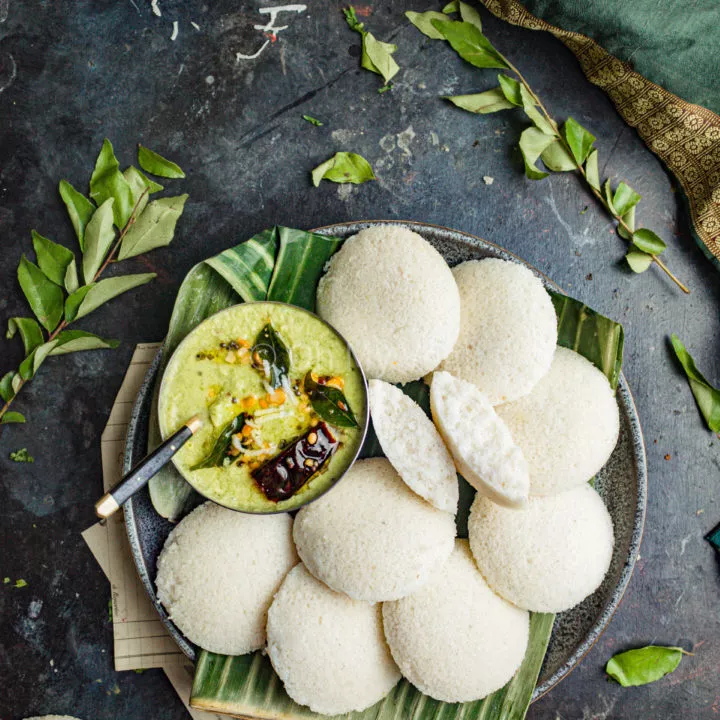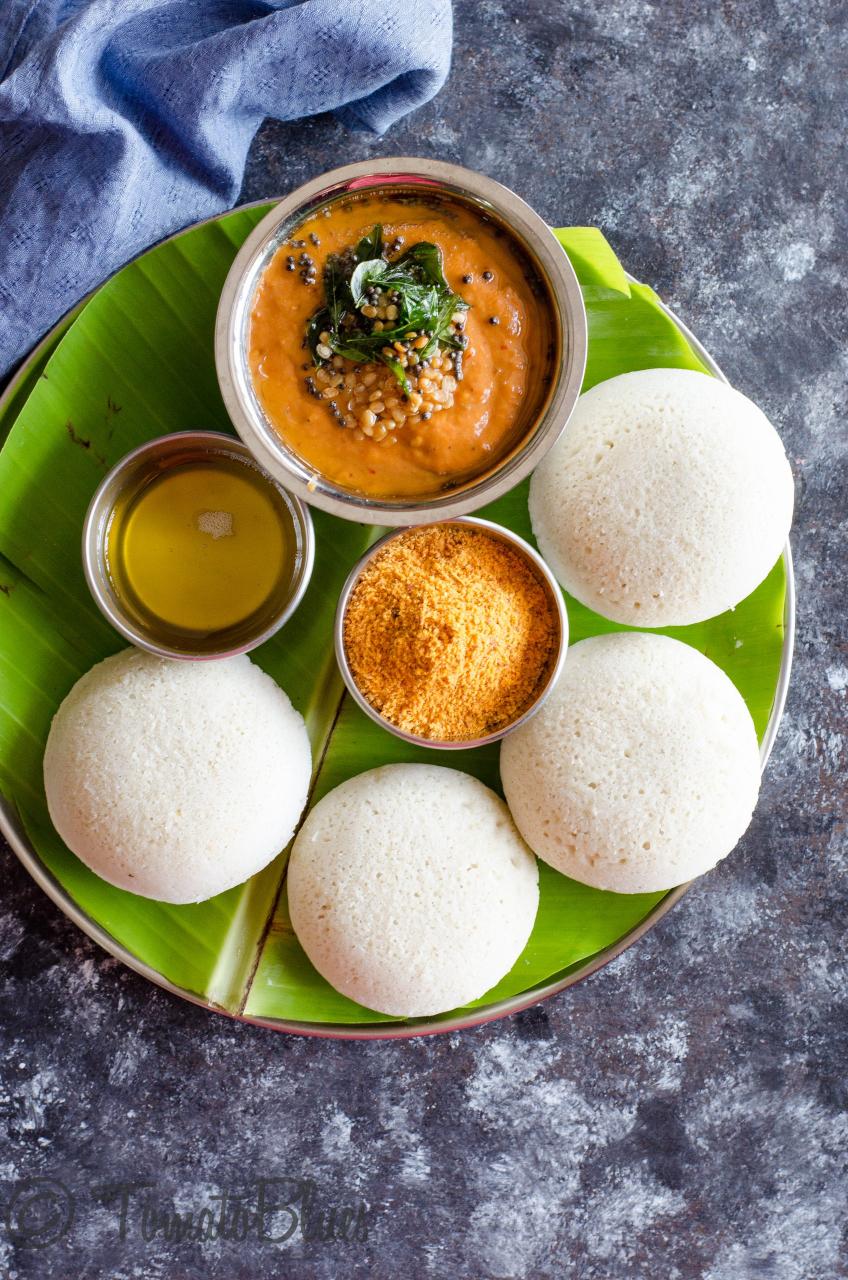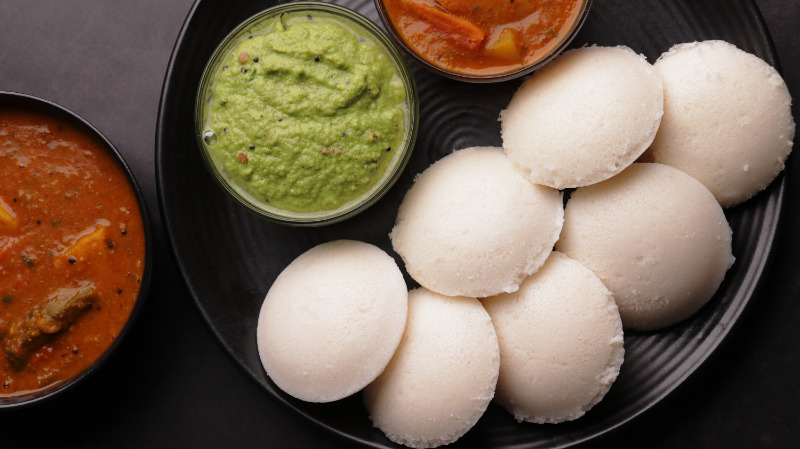Idli, a traditional Indian breakfast dish, is deeply cherished in the hearts and kitchens of South India, but its popularity extends throughout the entire subcontinent and beyond. It’s a savory steamed cake that embodies simplicity and nutrition, yet behind its modest appearance lies a profound cultural history and a meticulous cooking process that reflect the ingeniousness of Indian culinary traditions.
This traditional dish’s excellence comes not from complexity but from the mastery of simple techniques combined with quality ingredients. Whether you’re a culinary expert or a home cook, the journey of making idli from scratch is as rewarding as it is enriching. So, let’s embrace the warmth of Indian hospitality and the craft of its kitchens as we delve into the world of idli together.
Idli Recipe


Idli
Equipment
- 1 large bowl
- 1 blender
Ingredients
- 2 cups idli rice rinsed at least four times in cold water, drained well
- 1/2 cup husked whole black lentils rinsed at least four times in cold water, drained well
- 1 teaspoon fenugreek seeds
- 21/4 cups cold water divided
- 4 ice cubes
- 1 teaspoon salt
- 4 teaspoons vegetable or corn oil divided
Instructions
- In a large bowl, combine the rice and enough cold water to cover by 2 to 3 inches. In a medium bowl, combine the lentils, fenugreek seeds, and enough cold water to cover by 3 to 4 inches. Let both soak at room temperature for 6 to 8 hours.
- Drain the lentils and fenugreek seeds and transfer them to a blender. Blend until smooth, adding 1⁄2 to 3⁄4 cup cold water, a little at a time. Transfer the lentils to a large bowl.
- Drain the rice and add half to the blender. Add 2 ice cubes and about 1⁄2 cup of cold water and blend until smooth. Transfer the rice to the bowl with the ground lentils.
- Add the remaining rice, 2 ice cubes, and 1⁄2 cup of cold water to the blender. Grind the rice until smooth and add it to the bowl. Rinse the blender with the remaining 1⁄2 cup of cold water and add it to the batter. Add the salt.
- Using clean hands, mix the batter so the lentils and rice are well combined. The batter should be thick. Cover the bowl with a lid or plastic wrap and place it in a warm place—I keep nmine in the oven with the light on—to ferment for 8 to 10 hours. The batter should double in size and look frothy. Using a spoon or ladle, mix the batter one more time before preparing the idlis.
- Pour 1 cup of water into the steamer vessel and bring it to a boil over medium heat. Grease each mold on the idli plate with 1⁄4 teaspoon of oil. Fill each mold three-quarters full with batter.
- Arrange the plates and place them inside the steamer. Cover the steamer, reduce the heat to medium-low, and steam the idlis for 10 minutes.
- Turn off the heat and let the idlis cool, still covered in the steamer, for 5 minutes.
- Using a spoon, remove the idlis from the molds. Serve hot.
Notes
Cooking Tips about Idli
- Soaking: The rice and lentils are soaked separately in water for about 4 to 6 hours. Typically, the ratio of rice to lentils ranges between 3:1 and 4:1. The type of rice used can also vary, with idli rice specifically being preferred for its softer grain, but parboiled rice is also common.
- Grinding: After soaking, the lentils and rice are ground to a fine paste. The lentils are usually ground to a fine, fluffy consistency while the rice is ground to a slightly coarse texture. Traditionally, a stone grinder is used, but nowadays, electric blenders can also be utilized provided they can generate a smooth batter.
- Fermenting: The ground lentil and rice pastes are mixed together with salt, and the batter is left to ferment. This step is crucial as fermentation imparts the characteristic light and spongy texture to the idlis, as well as a slight sour flavor. The time required for fermentation will depend on the climate, with warmer climates accelerating the process (taking about 8-12 hours), while cooler climates may require more time (up to 24 hours).
- Steaming: Once the batter is fermented, it is poured into idli molds – usually circular indentations in metal trays – and then steamed. The steaming is typically done with a specialized idli steamer or in a pressure cooker without the weight. Thecooking time ranges from 10-15 minutes, depending on the size of the idlis and the intensity of the steam.
Serving suggestions about Idli

To enhance the experience of eating idli, service and accompaniment are crucial. Idlis are typically served with a variety of condiments and side dishes that add flavor, moisture, and complementary textures. The most common accompaniments are:
- Sambar – A flavorful lentil-based vegetable stew made with pigeon peas (toor dal), tamarind, a variety of vegetables like drumsticks, pumpkin, and eggplant, and a special blend of spices, including mustard seeds, curry leaves, asafoetida, and others. It provides a balance of flavors that complement the mildness of idli.
- Chutneys – There are several types of chutneys served with idli. The most popular are coconut chutney, which is made with grated coconut, green chilies, ginger, and mustard seeds, and is often tempered with curry leaves and asafoetida; and tomato chutney, which adds a tangy and slightly sweet flavor.
- Podi – Also known as ‘gunpowder’, it is a dry spice mixture of ground dry spices, such as dried chilies, urad dal, chickpea dal, and sesame seeds. Podi is typically mixed with sesame oil or ghee and dabbed onto the idli before eating.
For serving, idli is most appealing when presented freshly steamed and warm. It can be placed on a plate in a stack or arranged with a bowl of sambar and small cups of chutney on the side. In terms of presentation, garnishing with fresh curry leaves, coriander, or grated coconut can enhance the visual appeal and add a subtle flavor.
Top 5 FAQs about Idli

- What are the health benefits of Idli? Idli is considered a healthy food because it is steamed, contains no added fats, and is made from a fermented batter. Fermentation increases the bioavailability of nutrients and often enhances the vitamin B and C content. This process also reduces antinutrients like phytic acid, which can inhibit the absorption of minerals. Being rich in carbohydrates and proteins, it provides a balanced meal when paired with sambar or chutney, which adds vegetables and spices to the diet.
- How is Idli batter made? To make Idli batter, a mixture of parboiled rice and de-husked black lentils (urad dal) is soaked in water for several hours, then ground into a smooth, thick paste. This paste is then left to ferment, usually overnight. Fermentation is a crucial step as it contributes to the unique texture and flavor of the Idli. The ambient temperature plays a role in fermentation, with warmer climates generally speeding up the process.
- What is the texture and taste of Idli? Idli has a soft and spongy texture, due to the incorporation of air during the fermentation process and the steaming method of cooking. In terms of taste, Idli is mild and slightly tangy, a direct result of the fermentation process. It is often served with spicy or flavorful accompaniments like chutneys or sambar to complement its subtle flavor.
- Are there any variations of Idli? Yes, there are several variations of Idli. The most traditional version is made of rice and urad dal, but there are newer adaptations that incorporate other grains like ragi (finger millet) or even semolina (rava). Some variations also include different vegetables, herbs, and spices mixed into the batter. Additionally, certain variations change the shape and size of Idli, such as mini Idlis or button Idlis.
- How is Idli traditionally served? Traditionally, Idli is served with a variety of chutneys—coconut, mint, coriander, or tomato— and sambar, a flavorful lentil-based vegetable stew. It is common to pour a spoonful of sambar over Idli or to dip Idli in the sambar or chutneys while eating. Often, a sprinkle of ‘gun powder’ (a dry spicy powder made from ground lentils, chilies, and sesame seeds) may be added to enhance the flavor.
In conclusion, idli is a prominent dish in Indian culinary tradition, remarkable for its health benefits, simplicity, and adaptability to various accompaniments and dietary requirements.

Leave a Reply